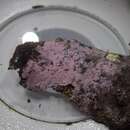tr
kırıntılardaki isimler


The Tulasnellaceae are a family of fungi in the order Cantharellales. The family comprises mainly effused (patch-forming) fungi formerly referred to the "jelly fungi" or heterobasidiomycetes. Species are wood- or litter-rotting saprotrophs, but many are also endomycorrhizal associates of orchids and some have also been thought to form ectomycorrhizal associations with trees and other plants.
The family was described in 1897 by the Swedish botanist and mycologist Hans Oscar Juel to accommodate species of fungi producing basidiocarps (fruit bodies) having distinctive basidia with grossly swollen sterigmata. He included two genera: Tulasnella itself and the poroid genus Muciporus (the latter subsequently found to be no more than Tulasnella species growing over the surface of old polypores).[1] In 1900, the French mycologist Narcisse Patouillard included the Tulasnellaceae within the heterobasidiomycetes or "jelly fungi"[2] and in 1922 British mycologist Carleton Rea placed the family in its own order, the Tulasnellales, within the heterobasidiomycetes.[3]
Molecular research, based on cladistic analysis of DNA sequences, has confirmed the Tulasnellaceae as distinct, but has placed the family within the Cantharellales, close to the Ceratobasidiaceae.[4] A standard 2008 reference work estimated that the family contains three genera and over 50 species.[5]
All but one of the species within the family form smooth, effused, corticioid basidiocarps that are distinguished microscopically by their distinctive "tulasnelloid" basidia. The monotypic genus Stilbotulasnella forms basidiocarps with similar basidia, but with an erect, "stilboid" anamorph. The latter genus has not been sequenced, but was originally described as belonging within the Tulasnellaceae.[6]
Basidiocarps of the Tulasnellaceae are typically found in woodland, on the underside of fallen wood or in leaf litter. They are believed to be soil fungi and many species have also been isolated from the roots of terrestrial[7] and epiphytic orchids.[8] They may also form ectomycorrhizal associations with trees and other plants.[9] Their distribution is cosmopolitan.
{{cite web}}: CS1 maint: archived copy as title (link) The Tulasnellaceae are a family of fungi in the order Cantharellales. The family comprises mainly effused (patch-forming) fungi formerly referred to the "jelly fungi" or heterobasidiomycetes. Species are wood- or litter-rotting saprotrophs, but many are also endomycorrhizal associates of orchids and some have also been thought to form ectomycorrhizal associations with trees and other plants.
Tulasnellilised (Tulasnellaceae) on sugukond kukeseenelaadsete seltsis.
Sugukonnas on kokku 54 liiki. Paljud neist on orhideede sümbiondid, moodustades mükoriisat.
Sellesse sugukonda kuuluvad järgmised perekonnad:
Tulasnellilised (Tulasnellaceae) on sugukond kukeseenelaadsete seltsis.
Sugukonnas on kokku 54 liiki. Paljud neist on orhideede sümbiondid, moodustades mükoriisat.
Les Tulasnellaceae sont une famille de champignons de l'ordre des Cantharellales. La famille comprend principalement les champignons épanchés appelés parfois champignons gélatineux (anciennement les hétérobasidiomycètes). Les espèces sont saprophages du bois ou de litière en décomposition, mais beaucoup sont également endomycorhiziennes, associées à des Orchidées et certaines forment des associations ectomycorhiziennes avec des arbres ou d'autres plantes.
Gymnocarpes, basides subglobuleuses, non septées, à deux ou quatre stérigmates volumineux. Spores germant en se renouvelant.
La famille a été décrite et créée en 1897 par le botaniste suédois et mycologue Hans Oscar Juel pour accueillir les espèces de champignons produisant des basidiocarpes (fructifications) ayant des basides distinctifs présentant des stérigmates très enflés[1]. La famille comprenait deux genres: Tulasnella lui-même caractérisé par une surface hyménienne lisse et les poroides à la surface poreuse, comme chez les polypores, du genre Muciporus. Ce dernier genre s'avérant plus tard être des espèces de Tulasnella qui poussent sur la surface des vieux polypores. En 1900, le mycologue français Narcisse Patouillard installait la famille des Tulasnellaceae dans les hétérobasidiomycètes ou champignons gélatineux[2] et, en 1922, le mycologue anglais Carleton Rea place la famille dans son ordre propre, les Tulasnellales, au sein des hétérobasidiomycètes[3].
De nos jours[Quand ?] la recherche moléculaire, basée sur les analyses cladistiques des séquences d'ADN, a confirmé la famille des Tulasnellaceae comme distincte, mais il a placé la famille au sein de l’ordre des Cantharellales[4], proche de celle des Ceratobasidiaceae. Depuis 2008, une nouvelle publication propose que cette famille comporte trois genres rassemblant une cinquantaine d'espèces[5], les deux nouveaux genres ne contenant que trois espèces.
Les espèces de la famille des Tulasnellaceae peuvent aussi former des associations ectomycorhiziennes avec des arbres et certaines plantes comme les orchidées épiphytes[6],[7].
Leur distribution est cosmopolite, le monogenre Stilbotulasnella n'est rencontré qu'au Guatémala.
Il contient deux espèces.
Il contient une espèce[8].
Genre le plus important de la famille des Tulasnellaceae, il contient une trentaine d'espèces.
Selon MycoBank (27 octobre 2013)[9] :
Selon Catalogue of Life (27 octobre 2013)[10] :
Selon NCBI (27 octobre 2013)[11] :
Les Tulasnellaceae sont une famille de champignons de l'ordre des Cantharellales. La famille comprend principalement les champignons épanchés appelés parfois champignons gélatineux (anciennement les hétérobasidiomycètes). Les espèces sont saprophages du bois ou de litière en décomposition, mais beaucoup sont également endomycorhiziennes, associées à des Orchidées et certaines forment des associations ectomycorhiziennes avec des arbres ou d'autres plantes.
Tulasnellaceae is een botanische naam, voor een familie van schimmels. Volgens de Index Fungorum [14 maart 2009] bestaat de familie uit de volgende zeven geslachten: Epulorhiza, Gloeotulasnella, Muciporus, Pachysterigma, Prototremella, Pseudotulasnella en Tulasnella.
Tulasnellaceae is een botanische naam, voor een familie van schimmels. Volgens de Index Fungorum [14 maart 2009] bestaat de familie uit de volgende zeven geslachten: Epulorhiza, Gloeotulasnella, Muciporus, Pachysterigma, Prototremella, Pseudotulasnella en Tulasnella.
Śluzowoszczkowate (Tulasnellaceae Jülich) – rodzina grzybów znajdująca się w rzędzie pieprznikowców (Cantharellales)[2].
Pozycja w klasyfikacji według Index Fungorum: Cantharellales, Incertae sedis, Agaricomycetes, Agaricomycotina, Basidiomycota, Fungi[1]. Rodzaje[2]:
Polskie nazwy na podstawie pracy Władysława Wojewody z 2003 r[3].
Śluzowoszczkowate (Tulasnellaceae Jülich) – rodzina grzybów znajdująca się w rzędzie pieprznikowców (Cantharellales).
Tulasnellaceae é uma família de fungos pertencente à ordem Cantharellales.[1][2]
Tulasnellaceae é uma família de fungos pertencente à ordem Cantharellales.